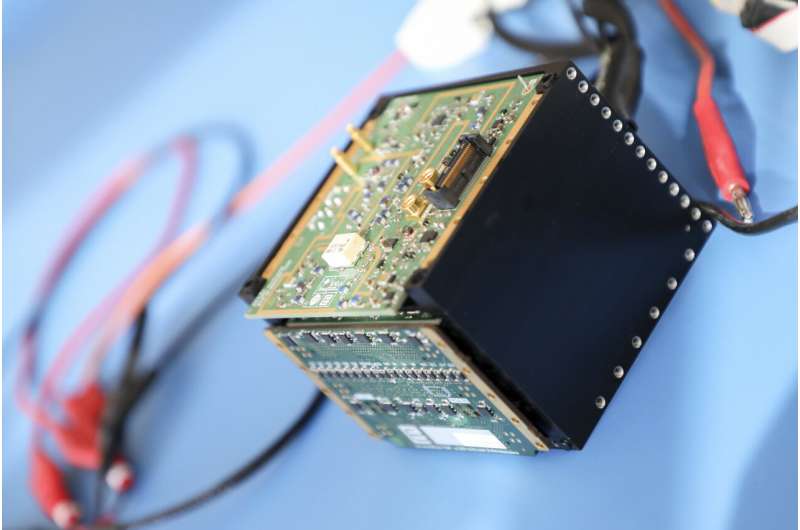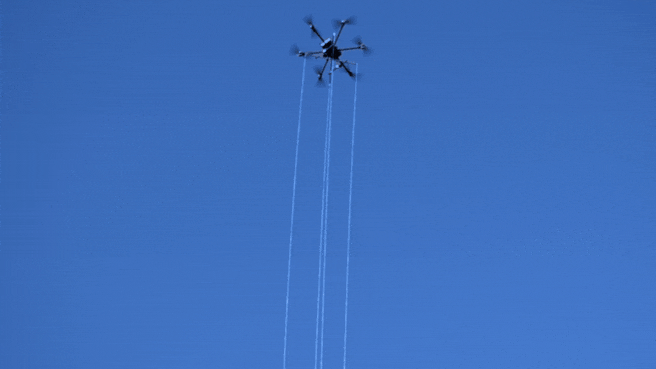This article has been reviewed according to Science X's editorial process and policies. Editors have highlighted the following attributes while ensuring the content's credibility:
fact-checked
trusted source
proofread
Hera's mini-radar will probe asteroid's heart

The smallest radar to fly in space has been delivered to ESA for integration aboard the miniature Juventas CubeSat, part of ESA's Hera mission for planetary defense. The radar will perform the first radar imaging of an asteroid, peering deep beneath the surface of Dimorphos—the Great Pyramid-sized body whose orbit was shifted last year by the impact of NASA's DART spacecraft.
"This delivery marks a definite milestone," comments Alain Hérique of Institut de Planétologie et d'Astrophysique de Grenoble (IPAG) at the University Grenoble Alpes in France, the instrument's principal investigator.
"We have been working hard in recent weeks to finalize the radar for its handover. But this is far from the end of our involvement. IPAG and our project partners will be following the process of integration, especially in terms of connection with the rest of the CubeSat, to optimize the performance of the finished instrument, and to calibrate its performance to ensure we interpret our science data as best we can once we are in space.
"Looking ahead, we will also be working on our operating procedures, to try out how we will be operating the instrument in practice, including hardware-in-the-loop testing where we will be commanding the radar via Hera and its CubeSat down on the ground."
Scheduled to fly to the Didymos binary asteroid system with ESA's Hera mission for planetary defense in 2024, the compact radar aboard the Juventas CubeSat will perform the first ever radar sounding inside an asteroid. Juventas will peer up to 100 m deep within the 160-m-diameter Dimorphos moonlet of the 780-m-diameter Didymos asteroid.

CubeSats are mini-satellites built up from standardized 10-cm boxes. Juventas is a "6-unit" CubeSat, measuring 10x20x30 cm, while the Juventas radar instrument—JuRa—for short measures 9.5x9.5x9.5 cm across, able to fit within a single CubeSat unit, along with a quartet of 1.5 m-long radar antennas—which will deploy like metal tape measures and have been manufactured by Astronika in Poland.
JuRa's radar electronics are the responsibility of EmTroniX in Luxembourg, a company that initially developed automotive electronics before expanding into designing and producing payloads and avionics for "New Space" missions.
"It feels good to deliver something to our customer, but it will feel even better once everything is fully integrated and tested," comments Cedric Lorant, EmTroniX co-founder and CEO.
"Once JuRa is integrated with the rest of the Juventas CubeSat, and we perform remaining tweaks such as re-flashing it to the latest firmware, then we will assess how the instrument performs within its working environment."
Planned to perform at least 45 hours of operations during the two-month working life of Juventas, JuRa incorporates some of the latest electronic components, but they had to undergo painstaking radiation testing ahead of delivery to ESA, because the space beyond Earth orbit is riven with charged particles that can degrade electronics.
The JuRa radar design—developed in IPAG in partnership with the Chair for Radio Frequency and Photonics Engineering of Technical University Dresden—is derived from a previous space radar flown on ESA's Rosetta mission, which plumbed the depths of comet 67P/Churyumov–Gerasimenko.
IPAG has also worked on radar systems for other space missions including NASA's Mars Reconnaissance Orbiter and ESA's Juice.
"JuRa is a small, low-frequency, radar for a small body, compared to the bigger instruments we have put together for planetary targets," adds Alain. "As with Rosetta around 67P, we take advantage of the fact we will be orbiting relatively slowly around the Dimorphos asteroid."
Hera will be moving at a few meters per second around the asteroid. This means JuRa can compensate for its comparative lack of power by transmitting the same signal multiple times, boosting its overall lack of power. The signal is specifically encoded to support the disentangling of radar returns, harnessing an EmTroniX-designed software-defined radio digital signal processor.
The full depth of radar penetration of JuRa's 60 MHz signal will depend on the consistency of Dimorphos. A more homogeneous interior will allow deeper sounding compared to a discontinuous rubble pile structure with big monoliths interspersed with empty voids.
The JuRa team has also been in discussion with ESA and other space agencies about the prospect of flying JuRa units to other asteroids, potentially including targeting the 2029 Earth flyby of the Apophis asteroid.
Provided by European Space Agency





















